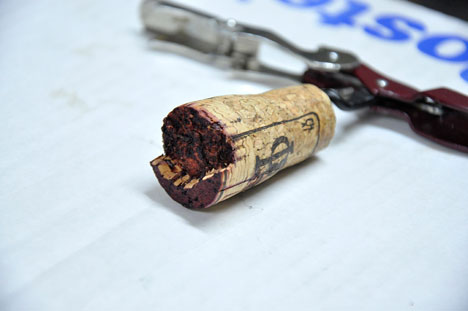The majority of Italian wines are still closed with stopper-type closures. Alternatives such as screw and glass closures or even crown corks have unfortunately been very rare up to now, although they have proven to be particularly suitable. The following overview briefly describes the most common closures and discusses their advantages and disadvantages. It should be noted that these do not only refer to their suitability as a means of closure, but also include factors such as consumer acceptance, economic and ecological aspects as well as ease of use and handling. The presentation does not claim to be exhaustive. Particularly rare variants such as ProCork (a natural cork whose ends are covered with a membrane that is supposed to keep out TCA) or the synthetic, air-permeable stoppers from the companies Korked or Guala, for example, are not included.
Advantages: Aesthetically pleasing, time-honoured, popping effect, accepted by consumers, ecological, recyclable. Long shelf life with top qualities.
Disadvantages: Risk of TCA (cork taint), great variance in gas permeability even between individual specimens of a cork batch, therefore inconsistent and unpredictable development of the wine, little guarantee of consistently high quality, risk of leaks.

|
| Natural cork (Photo: Merum) |
Advantages: Inexpensive, popping effect, consumers perceive it as a natural cork.
Disadvantages: High likelihood of TCA contamination, also risk of plastic and solvent notes (glue clay) caused by the adhesive used to bond the cork granules into stoppers.

|
| Agglomerate or agglomerated corks (Photo: Merum) |
Composite cork made of agglomerate body and natural cork discs. These are glued to one or both ends (two-disc cork) of the agglomerate body. Usually two-disc cork is used, as it then does not matter with which orientation it goes into the bottle.
Advantages: Inexpensive, popping effect, better alternative than a pure agglomerated cork.
Disadvantages: Despite natural cork discs, high risk of cork taint and glue clay, not suitable for storage.

|
| Disc cork (Photo: Merum) |
Special form of the disc cork, where two or even three natural cork discs are supposed to keep the wine away from the agglomerated part. These discs are usually of higher quality and have a greater thickness than is usual with cheap disc corks, thus ensuring more reliable taste neutrality. For cost reasons, one-piece natural corks are no longer on the market for sparkling wine. (For alternative see DIAM)

|
| Sparkling wine cork (Photo: Merum) |
Made of fine granules purified by a special process, DIAMANT technology, with supercritical CO2, making it free of TCA as well as numerous other molecules responsible for off-flavours. Available in different versions with varying oxygen permeability. Still wine corks carry the brand name DIAM, those for sparkling wines are called MYTIK.
Advantages: Natural cork-like aesthetics, popping effect, accepted by consumers, homogeneous cork structure, one cork looks like another, no risk of cork taint.
Disadvantages: So far, no sufficient experience regarding shelf life.

|
| DIAM cork (Photo: Merum) |
Advantages: No cork taste, inexpensive, popping effect.
Disadvantages: Slightly different oxygen permeability due to irregular pore distribution; short storage time due to limited impermeability (approx. 2 years), accelerated oxidation thereafter; in individual cases negative influence on the wine aroma due to the material used, especially if the bottle has been stored lying down.

|
| Plastic injection moulded cork (Photo: Merum) |
Plastic cork produced in a special process (co-extrusion). It consists of a foamed core surrounded by an elastic outer skin. Available in different versions to suit different storage times and oxygen permeability. According to the company, up to ten years storage time is possible with certain corks.
Advantages: No cork taste, popping effect, even development of wines in all bottles due to homogeneous cell structure of the core.
Disadvantages: In rare cases negative influence on the wine aroma, especially if the intended storage time for which the cork is designed and the bottle has been stored lying down has been exceeded. No sufficient experience regarding shelf life.

|
| Nomacorc plastic cork (Photo: Merum) |
Material aluminium. Different versions are available. On the one hand, a distinction is made between compound seals (plastic seal injected into the cap) and sealing discs inserted into the cap (multi-layered and in different compositions). Secondly, between different bottle mouths (MCA and BVS). There are also short or long caps. Sealing discs are common in screw caps with a long capsule.
Advantages: No cork taste, tight, neutral taste. Inexpensive. Constant wine quality of a filling batch. Can be opened without tools, can be resealed, opened bottles can be preserved without problems and for days from negative influences, long shelf life.
Disadvantages: Low acceptance. No popping effect. Technically demanding, cannot be applied with the usual machines. Development of reduction notes in the wine possible. High energy input in the production process.

|
| Twist or screw cap (Photo: Merum) |
Advantages: No cork taste, tight, tasteless, long shelf life, easy to apply.
Disadvantages: Hardly accepted by the consumer. Development of reduction notes in the wine possible.

|
| Crown cork (Photo: Merum) |
Advantages: Aesthetically pleasing, advantages as with screw cap.
Disadvantages: Expensive, cannot be applied with conventional machines. Development of reduction notes in the wine possible.

|
| Glass closure or Vino-Lok (Photo: Merum) |
Most of the closures used in Italy are made of cork material in one form or another. You can find natural corks, pressed or agglomerated corks as well as double-disc corks. The type and quality of cork used depends very much on the region and the appellation.
In South Tyrol, for example, an area with a far above-average focus on quality, the cork quality is also exceptionally high. Agglomerated or two-disc corks are rarely used there. The care with which the winegrowers work can already be seen in the closure.
Unfortunately, the Chianti DOCG, which is one of the most famous wines in Italy, is in stark contrast to this. Agglomerate and double-glass corks account for about 40 to 50 per cent. Especially wines that come onto the market young, i.e. one or two years after the harvest, are sealed with them.
Of course, there are also Chianti winemakers who work conscientiously not only in the vineyard and cellar, but are also concerned that the fruit of their painstaking work reaches the wine drinker's glass in exactly the same way as it left the ripening container at best: namely, in a pure tone!
Besides Chianti, many other appellations could be named that have a similarly high proportion of inferior cork closures; Frascati, for example, is one of them. And even in the wines of the Cinque Terre, where every spoiled bottle hurts twice as much due to the low availability, two-disc corks are used to a high degree.
The worst experiences we regularly have are with precisely these pressed or agglomerated corks or double-disc corks. Without a doubt, these corks have the most failures. I consider them absolutely unsuitable. It is negligent to close wine with them. The probability of spoiling it with this closure is very high.
By grinding the cork material, cork batches contaminated with TCA are mixed with uncontaminated batches. That is why the corkton, if it occurs in a batch of agglomerated corks, is to be found in all bottles of the bottling in question! In addition, with many pressed or agglomerated corks on the market, another off-flavour is very common besides the classic corkton, which is caused by the solvent-based adhesives used to form the cork shot into stoppers. Its smell has a plastic or solvent-like character.

|
| Wine drinker's frustration: composite cork with leaking% torn off natural cork. One of many examples of the unreliability of this type of closure. (Photo: Merum) |
Sensitivity to this so-called glue clay is very underdeveloped. One reason for this is that once it has appeared, it is present in all bottles of a batch with the same intensity, so there are no sensory differences between the individual bottles. Often, therefore, this off-flavour is blamed on the wine and not on the closure. However, it is easy to see that it is clearly attributable to the agglomerated cork when the same wine is bottled with different closures and the different samples are compared with each other after a certain period of bottle storage.
The double-disc cork (composite cork) is supposed to prevent the occurrence of TCA and glue clay. For this purpose, a disc of natural cork is glued to the ends of the agglomerate body. In this way, the wine is kept away from the agglomerate part of the cork. The extent to which the migration of the TCA and the soluble components of the adhesive into the wine is prevented depends on the quality of the natural cork discs. The less porous the natural cork discs are, the better their sealing behaviour.
Two-disc corks can delay the occurrence of the off-flavour, but with increasing bottle storage they are less and less able to prevent it altogether.
However, they are completely useless if the dimensions of the cork and the bottle neck are not perfectly matched and/or the cork lock is not precisely adjusted. In this case, the cork does not seal properly, wine gets between the bottle neck and the cork stopper and comes into contact with its agglomerate component.
So wines sealed with agglomerate or two-disc corks very often smell either corky or plastic-solvent-like, or even both. I wish more winemakers would become aware of this fact and abandon this type of cork.
A special form of agglomerated cork is the so-called DIAM cork. In a special process, the patented DIAMANT process, the finely ground cork material is purified by supercritical carbon dioxide from TCA and other substances responsible for any smelly tones. By means of pressure and heat and with the addition of polyurethane as a binder, the cork flour is then "baked" into a stopper.
Our experience with DIAM cork so far has been positive; it does not seem to have any of the sensory negative characteristics described above. Our current Prosecco tasting showed that this cork is fortunately also increasingly used in Italy.
According to our experience, the failure rate of natural corks has decreased significantly in recent years. The actual corkton occurs less frequently than in the past. Oxidation problems are almost more frequent with these bottles, either due to leakage or, in rare cases, due to the peroxides used for cork bleaching.

|
| Author Jobst von Volckamer has gained extensive experience with wine bottle closures in the course of his tasting practice. (Photo: Merum) |
To the magazine article "Screw tops are becoming socially acceptable".
To the magazine article "Winemakers' and associations' opinions on closures".
To the interview with Prof. Dr. Rainer Jung, Research Institute Geisenheim